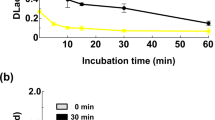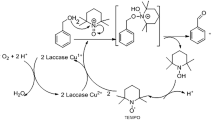Abstract
IN 1883 Yoshida1 discovered, in the latex of the Japanese lacquer tree (Rhus vernicifera), a thermolabile substance which was responsible for the darkening and hardening of the lacquer.
This is a preview of subscription content, access via your institution
Access options
Subscribe to this journal
Receive 51 print issues and online access
$199.00 per year
only $3.90 per issue
Buy this article
- Purchase on Springer Link
- Instant access to full article PDF
Prices may be subject to local taxes which are calculated during checkout
Similar content being viewed by others
References
Yoshida, H., J. Chem. Soc., 43, 472 (1883).
Bertrand, G., C.R., 118, 1215 (1894).
Suminokura, K., Biochem. Z., 224, 292 (1930); Bull. Chem. Soc. Japan, 11, 299 (1936).
Brooks, G., "Laque d'Indochine", Actualité scientifiques et industrielles, No. 94, 1–100 (1934).
Keilin, D., and Mann, T., Proc. Roy. Soc., B, 125, 187 (1938).
Kubowitz, F., Biochem. Z., 292, 221 (1937).
Mann, T., and Keilin, D., NATURE, 142, 148 (1938).
Keilin, D., Proc. Roy. Soc., B, 104, 206 (1929).
Kubowitz, F., Biochem. Z., 299, 32 (1938).
Author information
Authors and Affiliations
Rights and permissions
About this article
Cite this article
KEILIN, D., MANN, T. Laccase, a Blue Copper-Protein Oxidase from the Latex of Rhus succedanea. Nature 143, 23–24 (1939). https://doi.org/10.1038/143023b0
Issue Date:
DOI: https://doi.org/10.1038/143023b0
This article is cited by
-
Potential of the enzyme laccase for the synthesis and derivatization of antimicrobial compounds
World Journal of Microbiology and Biotechnology (2023)
-
Enhanced laccase-mediated transformation of diclofenac and flufenamic acid in the presence of bisphenol A and testing of an enzymatic membrane reactor
AMB Express (2018)
-
An evidence of laccases in archaea
Indian Journal of Microbiology (2009)
Comments
By submitting a comment you agree to abide by our Terms and Community Guidelines. If you find something abusive or that does not comply with our terms or guidelines please flag it as inappropriate.



